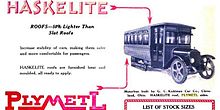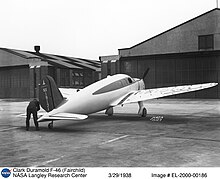| Revision as of 16:41, 5 May 2020 editLegobot (talk | contribs)Bots1,669,585 editsm Adding Good Article icon← Previous edit | Latest revision as of 14:28, 15 July 2024 edit undoInternetArchiveBot (talk | contribs)Bots, Pending changes reviewers5,384,417 edits Rescuing 1 sources and tagging 0 as dead.) #IABot (v2.0.9.5 | ||
| (71 intermediate revisions by 19 users not shown) | |||
| Line 1: | Line 1: | ||
| ⚫ | {{Short description|Brand of plywood by Haskelite Manufacturing Corporation}} | ||
| {{good article}} | |||
| ] | ] | ||
| ''' Haskelite ''' is the brand name of a plywood, once made by the Michigan-based |
''' Haskelite ''' is the brand name of a plywood, once made by the Michigan-based Haskelite Manufacturing Corporation. It was made from waterproof glue developed by {{Interlanguage link|Henry L. Haskell|fr}}. The moldable ] was originally called Ser-O-Ply. It was used in the construction of various vehicles including ], boats, airplanes, buses, trucks, and automobiles. The plywood was manufactured with different characteristics depending on particular needs and then given a brand name. | ||
| == Background == | == Background == | ||
| Haskell invented a process for making |
Haskell invented a process for making a waterproof glue called "black ] glue"<ref name=blackglue>{{cite web |url=https://www.wcha.org/content/haskell-boat-company |title=Manufacturers: Haskell Boat Company |author=<!--Staff writer(s); no by-line.--> |date=2016 |website=W C H A |publisher=Wooden Canoe Heritage Association |access-date=May 12, 2016 |archive-date=October 28, 2020 |archive-url=https://web.archive.org/web/20201028192149/http://www.wcha.org/content/haskell-boat-company |url-status=dead }}</ref> which was used to ].<ref>{{Cite book |url=https://books.google.com/books?id=8r_kAAAAMAAJ&q=Haskelite |title=Veneers and Plywood |date=1930 |publisher=S.H. Smith. |volume=24 |page=19 |language=en}}</ref><ref name=PlyBus>{{cite news |last=Williams |first= Leonard P. |date= December 22, 1952 |title= Into Plywood Business |url=https://www.newspapers.com/clip/5153556// |newspaper=] |location= Ludington, Michigan |page=7 |via=] {{open access}} }}</ref> The sheets made this way were eventually given the brand trade name of "Haskelite" after the inventor.<ref>{{cite magazine |magazine=Motor Boat |title=Haskelite, a Plywood for Boat Construction |url=https://books.google.com/books?id=M-k_AQAAMAAJ&q=canoe&pg=RA7-PA38 |page=38 |date=November 10, 1920 |volume=17}}</ref> | ||
| Haskell formed a company for making plywood that ultimately became the ] in ] and the ] in ]. The glue was applied cold and spread onto wood veneers with rollers. A stack of three sheets of veneer was then put through a press, where each panel was subjected to a pressure of 150 psi between metal plates at {{convert|210|F|C}}.{{sfn|Motor_Body|1919|p=54}} This pressure and heat made the bond between the veneers permanent and the glue became ].{{sfn|Dunbar|1955|p=439}} The plywood was given brand names depending on its characteristics.{{sfn|Hardwood_Record|1920|p=30}} Plymetl had metal faces and was used in construction of ] for storing furs and expensive garments.<ref name=Plymetl>{{cite news |author=<!--Staff writer(s); no by-line.--> |title= Plymetl "Air-Tite" cloths vault |url= https://www.newspapers.com/clip/50083230/ |newspaper=Chicago Tribune |location=Chicago, Illinois|date=November 9, 1923 |via=] {{open access}} }}</ref> Plymold was a plastic-based plywood that could be molded, and Phemaloid was a fire-resistant paneling.{{sfn|Marine_Engineering|1933|p=208-213}} | |||
| == Boats == | |||
| ⚫ | {{ |
||
| ⚫ | ] | ||
| ⚫ | |||
| == Airplanes == | == Airplanes == | ||
| {{ |
{{See also|Fairchild F-46}} | ||
| ] | ] | ||
| Haskell plywood was used for construction of experimental and commercial aircraft.<ref name=Hughes>{{cite news |author=<!--Staff writer(s); no by-line.--> |title=Haskelite, Hughes to Build Planes |url=https://www.newspapers.com/clip/5240634// |newspaper=The Ludington Daily News |date=August 1, 1939 |page=1 |via=Newspapers.com {{open access}} }}</ref><ref name=Twin60>{{cite journal |date=1927 |title= New Johnson Twin 60 adopts Haskelite |url=https://archive.org/stream/aerodigest1019unse/aerodigest1019unse_djvu.txt |journal= Aero-Digest |volume=10 |page= 2|access-date=May 12, 2016}}</ref> The first successful commercial airplane it was used on was the 1937 ] ].<ref name=firstplane>{{cite news |author=<!--Staff writer(s); no by-line.--> |title=Ludington is Birthplace of Plywood Airplanes |url=https://www.newspapers.com/clip/5239496// |newspaper=The Ludington Daily News |date=July 15, 1943 |page=3 |via=Newspapers.com {{open access}} }}</ref> | |||
| The |
The company produced plywood for use in ] aircraft.<ref name=war_effort>{{cite news |first=James L. |last=Cabot |date=June 26, 1993 |title=Local Company Contributed to war effort |url=https://news.google.com/newspapers?nid=110&dat=19930626&id=ljVQAAAAIBAJ&pg=2161,7253929&hl=en |newspaper=The Ludington Daily News |page=4 }}</ref><ref name=Diversified>{{cite news |author=<!--Staff writer(s); no by-line.--> |title=Carrom Company Is Diversified |url=https://www.newspapers.com/clip/5229992// |newspaper=The Ludington Daily News |date=September 3, 1965 |page=13 |via=Newspapers.com {{open access}} }}</ref>{{sfn|Beld|2012|p=99}} | ||
| === Duramold === | === Duramold === | ||
| {{main|Duramold}} | |||
| A Haskelite specialty plywood designed for aircraft construction called Duramold was invented in 1939. The new plastic plywood consisted of thin veneers of wood and cloth that were impregnated with ] and ] and sandwiched with a synthetic resin. Heat and pressure were used to bold the materials together. The specialty plywood was only about one-third as heavy as the aluminum alloys then used in manufacturing airplanes. ] tests proved that for its weight it was stronger than metal. The plastic plywood was waterproof and could readily be formed into compound curvatures. Processes had been developed so that an entire fuselage could be turned out in two halves. They then were sealed together mechanically. Wing assemblies also were molded with this process.<ref name=Duramold>{{cite news |author=<!--Staff writer(s); no by-line.--> |title= New Process Developed by Chicago Firm |url=https://www.newspapers.com/clip/50067134/chicago-tribune/ |newspaper= Chicago Tribune |location= Chicago, Illinois|date=January 22, 1939 |via=] {{open access}} }}</ref> | |||
| In 1939 a waterproof plywood called Duramold, consisting of thin ] and cloth joined using glue, heat and pressure, and designed for aircraft construction was invented.<ref name=Duramold>{{cite news |author=<!--Staff writer(s); no by-line.--> |title= New Process Developed by Chicago Firm |url=https://www.newspapers.com/clip/50067134/chicago-tribune/ |newspaper= Chicago Tribune |date=January 22, 1939 |page=25 |via=Newspapers.com {{open access}} }}</ref> | |||
| The ] and Haskelite Manufacturing joined the Clark Aircraft Company of ] |
The ] and Haskelite Manufacturing joined the ] of ] to manufacture planes designed by ] using ].<ref name=Speedy>{{cite news |author=] |title= Speedy Production of Planes is Seen |url= https://www.newspapers.com/clip/50079347/ |newspaper= ] |date=July 9, 1939 |page=9|via= Newspapers.com {{open access}} }}</ref> | ||
| == |
== Boats and canoes == | ||
| ⚫ | ]]] | ||
| ⚫ | Haskelite was also used to make watercraft.<ref name=NewMaterial>{{cite news |author=<!--Staff writer(s); no by-line.--> |title=New Material Used in Boats |url= https://www.newspapers.com/clip/5240989/ |newspaper= ] |location= Benton Harbor, Michigan |date=June 24, 1939 |pages=1, 3|via=Newspapers.com {{open access}} }}</ref> | ||
| * ] | |||
| * ] | |||
| ⚫ | |||
| == References == | == References == | ||
| Line 38: | Line 31: | ||
| == Sources == | == Sources == | ||
| *{{cite book |
*{{cite book |last=Beld |first=Gordon G. |title= The Early Days of Aviation in Grand Rapids |url=https://books.google.com/books?id=n5l2CQAAQBAJ&q=Haskelite |year=2012|isbn=978-1-61423-805-8 |publisher=Arcadia Publishing |location=Charleston, South Carolina |oclc=945368042 }} | ||
| ⚫ | *{{cite book |
||
| == Further reading == | |||
| * {{cite book|ref=harv|last=Hardwood_Record|first=|title=Hardwood Record|url=https://books.google.com/books?id=kgI3AQAAMAAJ&pg=PA29|year=1920|publisher=Hardwood Company|location=Chicago, Illinois}} | |||
| ⚫ | *{{cite book |last=Dunbar |first=Willis Frederick |title=Michigan Through the Centuries |url=https://books.google.com/books?id=zn3hAAAAMAAJ |year=1955 |publisher=Lewis Historical Publishing Company |location=Detroit, Michigan}} | ||
| *{{cite book|ref=harv|last=Kane|first=Joseph Nathan|title=Famoue First Facts and Records|url=https://books.google.com/books?id=NttiC-UaOTMC|quote= The first airplane of molded plywood was the "Whistling Bill," a two-place fighter, built in 1918 by the Curtiss Aeroplane and Motor Company, Garden City, Long Island, N.Y. The fuselage was made of four 3/32nd-inch longitudinal sheets of Haskelite, three-ply birch plywood, steamed and formed to contour in a concrete die.|publisher=The ]|location= New York City}} | |||
| * {{cite |
* {{cite magazine |title=Marine Engineering and Shipping Age |volume=38 |date=June 1933 |pages=208–213 |url=https://books.google.com/books?id=FW3mAAAAMAAJ&q=Haskelite }} | ||
| * {{cite news |author=<!--Staff writer(s); no by-line.--> |title=Plastic Airplane Industry is near |url= https://www.newspapers.com/clip/50078408/ |newspaper= ] |location= Lansing, Michigan |date=August 10, 1939 |page=3 |via=Newspapers.com {{open access}} }} | |||
| *{{cite book|ref=harv|last=Motor_Boat|first=|title=Motor Boat|url=https://books.google.com/books?id=M-k_AQAAMAAJ&pg=RA7-PA38|year=1920|publisher=Motor Boat Publishing Company}} | |||
| *{{cite book|ref=harv|last=Motor_Body|first=|title=Motor Body, Paint and Trim|url=https://books.google.com/books?id=--w_AQAAMAAJ&pg=RA3-PA54|year=1919|publisher=Motor Boat Publishing Company}} | |||
| *{{cite book|ref=harv|last=Smith|first=S.H.|title=Veneers and Plywood|url=https://books.google.com/books?id=8r_kAAAAMAAJ|year=1930|publisher=S.H. Smith.}} | |||
| == External links == | == External links == | ||
| {{Commons}} | *{{Commons category-inline|Haskelite}} | ||
| ⚫ | *{{Commons category-inline|Haskell canoe}} | ||
| ] | ] | ||
| ] | ] | ||
| ] | |||
Latest revision as of 14:28, 15 July 2024
Brand of plywood by Haskelite Manufacturing Corporation
Haskelite is the brand name of a plywood, once made by the Michigan-based Haskelite Manufacturing Corporation. It was made from waterproof glue developed by Henry L. Haskell [fr]. The moldable plywood was originally called Ser-O-Ply. It was used in the construction of various vehicles including military tanks, boats, airplanes, buses, trucks, and automobiles. The plywood was manufactured with different characteristics depending on particular needs and then given a brand name.
Background
Haskell invented a process for making a waterproof glue called "black albumin glue" which was used to bond wood. The sheets made this way were eventually given the brand trade name of "Haskelite" after the inventor.
Airplanes
See also: Fairchild F-46
Haskell plywood was used for construction of experimental and commercial aircraft. The first successful commercial airplane it was used on was the 1937 Fairchild Aircraft F-46.
The company produced plywood for use in World War I aircraft.
Duramold
Main article: DuramoldIn 1939 a waterproof plywood called Duramold, consisting of thin veneers of wood and cloth joined using glue, heat and pressure, and designed for aircraft construction was invented.
The General Bakelite Company and Haskelite Manufacturing joined the Clark Aircraft Company of Hagerstown, Maryland to manufacture planes designed by Virginius E. Clark using Duramold.
Boats and canoes

Haskelite was also used to make watercraft.
References
- "Manufacturers: Haskell Boat Company". W C H A. Wooden Canoe Heritage Association. 2016. Archived from the original on October 28, 2020. Retrieved May 12, 2016.
- Veneers and Plywood. Vol. 24. S.H. Smith. 1930. p. 19.
- Williams, Leonard P. (December 22, 1952). "Into Plywood Business". The Ludington Daily News. Ludington, Michigan. p. 7 – via Newspapers.com
 .
.
- "Haskelite, a Plywood for Boat Construction". Motor Boat. Vol. 17. November 10, 1920. p. 38.
- "Haskelite, Hughes to Build Planes". The Ludington Daily News. August 1, 1939. p. 1 – via Newspapers.com
 .
.
- "New Johnson Twin 60 adopts Haskelite". Aero-Digest. 10: 2. 1927. Retrieved May 12, 2016.
- "Ludington is Birthplace of Plywood Airplanes". The Ludington Daily News. July 15, 1943. p. 3 – via Newspapers.com
 .
.
- Cabot, James L. (June 26, 1993). "Local Company Contributed to war effort". The Ludington Daily News. p. 4.
- "Carrom Company Is Diversified". The Ludington Daily News. September 3, 1965. p. 13 – via Newspapers.com
 .
.
- Beld 2012, p. 99.
- "New Process Developed by Chicago Firm". Chicago Tribune. January 22, 1939. p. 25 – via Newspapers.com
 .
.
- New York Herald Tribune (July 9, 1939). "Speedy Production of Planes is Seen". The Miami News. p. 9 – via Newspapers.com
 .
.
- "New Material Used in Boats". The News-Palladium. Benton Harbor, Michigan. June 24, 1939. pp. 1, 3 – via Newspapers.com
 .
.
Sources
- Beld, Gordon G. (2012). The Early Days of Aviation in Grand Rapids. Charleston, South Carolina: Arcadia Publishing. ISBN 978-1-61423-805-8. OCLC 945368042.
Further reading
- Dunbar, Willis Frederick (1955). Michigan Through the Centuries. Detroit, Michigan: Lewis Historical Publishing Company.
- "Marine Engineering and Shipping Age". Vol. 38. June 1933. pp. 208–213.
{{cite magazine}}: Cite magazine requires|magazine=(help) - "Plastic Airplane Industry is near". Lansing State Journal. Lansing, Michigan. August 10, 1939. p. 3 – via Newspapers.com
 .
.
External links
 Media related to Haskelite at Wikimedia Commons
Media related to Haskelite at Wikimedia Commons Media related to Haskell canoe at Wikimedia Commons
Media related to Haskell canoe at Wikimedia Commons